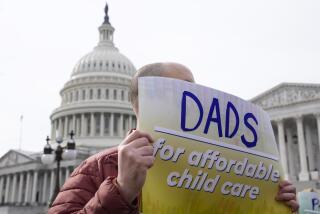PERSPECTIVE ON EDUCATION : Every Child Can Have a Head Start : This program works and can easily be expanded; being prepared for school isn’t a middle-class birthright.
- Share via
Now that the vice president has resumed the fight over “family values,” let’s go back over the battleground of the Dan Quayle-Murphy Brown engagement. Does it offer any useful lesson?
There is one, though hardly the one that Quayle intended. It is that all children should have it as good as Murphy Brown’s son is likely to, and that there are concrete steps the nation can take to that end.
Consider what Baby Brown has going for him. His mother has a nice house and stable income. If she hits a dry spell, the baby’s father would pay child support. There are friends to bring baby clothes, casseroles and encouragement. Murphy’s work leaves time and energy to enjoy her son, to read to him, to teach him those first lessons of right and wrong, of affection and mutual trust.
As a toddler he would be learning from his mother, nanny or child-care center the basic concepts of bigger and smaller, now and later, yours and mine. He would be romping on the floor without fear of being bitten by rats and playing outside without having to dodge stray bullets. A pediatrician would be tracking his development and he would be up to date with his shots. At age 5, he would have reached the first education goal set by the President and the nation’s governors--arriving at school ready to learn. His chances of success at school and in life would be high.
Of course, these chances are affected by individual endowment and family circumstances. But they are also powerfully determined by how well the community and the society support families in their child rearing.
From the welter of proposals to address the urban devastation, providing a decent start for children must be singled out because the early years are so crucial and because we already have a wealth of experience to guide us.
As a nation, we now know how to strengthen families in their child-rearing, and it is possible to act immediately on what we know. Thus, we should begin the renewal of our cities with a massive new investment in the youngest children.
The latest research shows that the first three years of life are critical to all aspects of later development. We propose combining something old with something new: Use the structure of Head Start, which helps just 4-year-olds, to finance and organize an array of services and family supports that begin before birth.
In making choices about allocating limited resources, we must move swiftly in areas of proved effectiveness. Head Start is a proven intervention. But what is needed is a Head Start that is expanded upward, downward and sideways.
The Head Start of the 1990s would provide needy families with a beacon of hope and a source of support for all of the years between birth and school entry. It would include home visits, immunizations, prenatal care, parent-child centers, full-day child care and parent support and education. Local Head Start programs would collaborate with elementary schools to assure that the schools are ready for the children. They could directly provide or be linked with adult job training, drug treatment and economic development programs. The programs could be free-standing or attached to schools, settlement houses or other community institutions.
Those of us involved in founding Head Start in 1965 knew that its mix of child care, preschool education, social services, health care and parent involvement could not, alone, guarantee school success and inoculate against later misfortune. But we also believed, and careful studies have confirmed, that participation in Head Start would increase a child’s likelihood of success at school and in life. Therefore it is scandalous that even today the nation puts up only enough money for 30% of all eligible children to participate.
Many thoughtful Americans hesitate to support bolder moves because they worry that no one really knows what to do; they fear that there will not be enough visible results to justify the investment. But it is the very timidity of many of our efforts that has guaranteed disappointment. Diluted, piecemeal services and supports, grudgingly delivered, don’t change lives. By contrast, programs that are comprehensive, responsive and flexible; that provide services in a user-friendly, non-bureaucratic atmosphere; that foster respectful, empowering relationships between staff and participants, have succeeded--often beyond our fondest dreams.
Preventive programs with these attributes save anywhere from three to six times their initial cost, when the savings are calculated in terms of money that would not have to be spent on neonatal intensive care, special education or out-of-home placements. The savings in lives not wasted are much higher.
This proposal could utilize in an integrated way the funds that now support fragmented health, child-care, nutrition and social services. With about one-third of the 4 million children born each year qualifying for participation, the fully operational program would cost no more than $20 billion in new money annually, an amount equal to about a 7% reduction in the Bush Administration’s proposed defense budget.
The investment would be repaid many times over, in stronger children and families, healthier communities and a less polarized nation.






